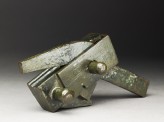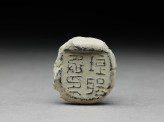Room 10 | China 3000 BC-AD 800 gallery
Discover over 3000 years of Chinese history and culture through surviving artefacts, objects and texts.

Calligraphy on objects
In China, writing was rendered on different media. There were talismanic texts on bronze mirrors to avert evils; auspicious words on roof tile ends to invite blessings; personal names on weapons and pottery to signify ownership; and reign marks on bronze coins to declare dates.
 Mirror with inscription in lishu, or clerical script (EA1956.1563)
Mirror with inscription in lishu, or clerical script (EA1956.1563)
 Mirror with inscription in lishu, or clerical script (EA1956.1574)
Mirror with inscription in lishu, or clerical script (EA1956.1574)
 End-tile with inscription (EAX.1199)
End-tile with inscription (EAX.1199)
Calligraphy painting
 Greenware water pot in the form of a frog (EA1956.229)
Greenware water pot in the form of a frog (EA1956.229)
 Greenware water pot in the form of a frog (EA1956.949)
Greenware water pot in the form of a frog (EA1956.949)
 Greenware water pot in the form of a frog (EA1956.950)
Greenware water pot in the form of a frog (EA1956.950)
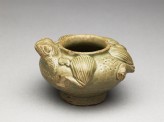 Greenware water pot in the form of a frog (EA1956.951)
Greenware water pot in the form of a frog (EA1956.951)
 Greenware water pot in the form of a frog (EA1956.980)
Greenware water pot in the form of a frog (EA1956.980)
 Greenware water pot in the form of a frog (EA1956.983)
Greenware water pot in the form of a frog (EA1956.983)
 Greenware water pot in the form of a frog (EA1956.984)
Greenware water pot in the form of a frog (EA1956.984)
 Soapstone seal surmounted by shishi, or lion dog, and seven pups (EA1970.45)
Soapstone seal surmounted by shishi, or lion dog, and seven pups (EA1970.45)
 Calligraphy about the fame of Wang Xianzhi (EA2000.156.e)
Calligraphy about the fame of Wang Xianzhi (EA2000.156.e)
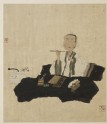 Wang Xianzhi with a writing brush (EA2000.156.f)
Wang Xianzhi with a writing brush (EA2000.156.f)
Calligraphy rubbings
Calligraphy tools
Brushes, ink, inkstones and other objects associated with writing and calligraphy have been in use for more than two thousand years. They were often elaborately carved in fine materials, particularly in the Ming and Qing dynasties when they were highly regarded, and sometimes signed by individual craftsmen. Seals were originally used for applying marks of identity, ownership and authentication. After about AD 1000, artists carved their own seals with their names, or favourite phrases and quotations.
 Porcelain seal surmounted by shishi, or lion dog, and pup (EA1956.3281)
Porcelain seal surmounted by shishi, or lion dog, and pup (EA1956.3281)
 Moulded ink cake with landscape (EA1963.29)
Moulded ink cake with landscape (EA1963.29)
 Brass seal with Chinese and Manchu script (EA1970.19)
Brass seal with Chinese and Manchu script (EA1970.19)
 Soapstone seal surmounted by six-legged toad (EA1970.57)
Soapstone seal surmounted by six-legged toad (EA1970.57)
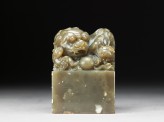 Jade seal surmounted by lion-dog with four pups and ball (EA1970.60)
Jade seal surmounted by lion-dog with four pups and ball (EA1970.60)
 Ivory seal with dragon (EA1970.65)
Ivory seal with dragon (EA1970.65)
 Jade seal surmounted by four dragons and a phoenix (EA1970.66)
Jade seal surmounted by four dragons and a phoenix (EA1970.66)
 Lacquer writing brush and lid with peonies (EA1967.198)
Lacquer writing brush and lid with peonies (EA1967.198)
 Blue-and-white seal surmounted by a shishi, or lion dog (EA1976.45)
Blue-and-white seal surmounted by a shishi, or lion dog (EA1976.45)
 Porcelain seal surmounted by a seated animal (EA1976.119.a)
Porcelain seal surmounted by a seated animal (EA1976.119.a)
 Porcelain seal surmounted by a seated animal (EA1976.119.b)
Porcelain seal surmounted by a seated animal (EA1976.119.b)
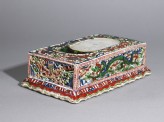 Porcelain inkstone decorated with dragons chasing fiery pearls (EA1980.403)
Porcelain inkstone decorated with dragons chasing fiery pearls (EA1980.403)
 Ink cake in the form of a brush washer (EA2004.3)
Ink cake in the form of a brush washer (EA2004.3)
 Water pot in the form of a lychee spray (EAX.1255)
Water pot in the form of a lychee spray (EAX.1255)
 Brush rest in the form of a mountain (EAX.1813)
Brush rest in the form of a mountain (EAX.1813)
 Ink stick with scene of scholar in garden (EAX.5513)
Ink stick with scene of scholar in garden (EAX.5513)
 Ink stick with ploughing scene (EAX.5514)
Ink stick with ploughing scene (EAX.5514)
 Ink stick with two figures in landscape (EAX.5515)
Ink stick with two figures in landscape (EAX.5515)
 Ink stick with fishing scene (EAX.5516)
Ink stick with fishing scene (EAX.5516)
 Ink stick with scene of river village at dusk (EAX.5517)
Ink stick with scene of river village at dusk (EAX.5517)
Notice
Objects may have since been removed or replaced from a gallery. Click into an individual object record to confirm whether or not an object is currently on display. Our object location data is usually updated on a monthly basis, so contact the Jameel Study Centre if you are planning to visit the museum to see a particular Eastern Art object.
© 2013 University of Oxford - Ashmolean Museum

